Lack Of Sweatingaccording to TCM
Symptom family: Sweating Disorders
Root Causes of Lack Of Sweating in TCM
Explore below more details about what might cause Lack of sweating according to TCM.
- By Syndrome
- By Organ
- Cold
- Wind
- Phlegm
- Heat
- Dampness
- Yin Deficiency
- Yang Excess
- Yang Deficiency
- Dryness
- Summer Heat
- View More Causes
- Lung
Cold
In TCM "Cold" as a pattern of disharmony refers to a specific type of imbalance within the body's systems, often linked to a deficiency or weakness. It's not about feeling physically cold or having a common cold, but rather a metaphorical description of certain symptoms and underlying conditions. When a TCM practitioner says someone suffers from "Cold," it usually implies that the body's Yang energy, which is warm and active, is insufficient or overpowered by Yin energy, which is cool and passive. Symptoms of Cold in TCM can include a general feeling of coldness, cold limbs, pale complexion, low energy, slow metabolism, and a preference for warmth. ... see more
Cold Patterns That Can Lead to Lack Of Sweating
Common Symptoms: Headaches Aversion To Cold Fever Body Pain Chills Sneezing Nasal Discharge Occipital Headache
| Pattern Name | Relevant Symptoms | Relevant Formulas |
|---|---|---|
| Greater Yang Attack of Cold | Absence of sweating, Occipital headache, Aversion to cold, Low grade fever, Lack of sweating, Stiff neck, Sneezing, Nasal discharge, Shortness of breath... see more | Ma Huang Tang |
| Wind-Cold invading the Lungs | Lack of sweating, Aversion to cold, Fever, Itchy throat, Shortness of breath, Congested nose, Nasal discharge, Sneezing, Headaches, Body pain, White and watery sputum, Coughing and wheezing with copious sputum... see more | Ma Huang Tang | Ge Gen Tang | Xin Yi San | Zhi Sou San |
| Dry-Cold | No sweat, Fever, Headaches, Aversion to cold, Skin dryness, Lack of sweating, Dry mouth, Dry throat, Coughing, Scanty sputum... see more | Xing Su San |
| Exterior-Cold | No sweat, Aversion to cold, Fever, Body pain, Stiff neck, Lack of sweating, Absence of thirst, Feeling hot, Chills... see more | Ma Huang Tang | Gui Zhi Tang |
| Wind-Cold | No sweat, Aversion to cold, Fever, Sneezing, Coughing, Nasal discharge, Occipital headache, Occipital stiffness, Congested nose, White and watery sputum... see more | Ma Huang Tang | Jing Fang Bai Du San | Cong Chi Tang | Huo Ren Cong Shi Tang | Jiu Wei Qiang Huo Tang | Jia Wei Xiang Su San | Shi Shen Tang | Jin Fei Cao San | Wu Ji San |
| Early Stage Summerheat with Exterior Wind-Cold | No sweating, Fever, Chills, Lack of sweating, Headaches, Thirst, Flushed face, Stifling sensation in the chest, Feeling of heaviness, Body pain, Dark urine, Urinary dysfunction... see more | Xin Jia Xiang Ru Yin |
| Exterior Cold with Interior Dampness in Summer | No sweating, Chills with warm skin, Lack of sweating, Heavy sensation in the head, Headaches, Abdominal pain, Vomit, Diarrhea, Tight feeling in chest and stomach, Fatigued extremities, Nausea... see more | Xiang Ru San |
| Wind Cold with Internal Heat | No sweating, Strong fever, Severe chills, Lack of sweating, Headaches, Feeling of heaviness, General sensation of tightness, Flushed face, Eye hyperemia, Dry nose, Thirst, Irritability, Insomnia, Hemoptysis, Mottled skin... see more | Shi Gao Tang |
| Wind-Cold invading with Yang Deficiency | No sweating, Low grade fever, Severe chills, Exhaustion, Hypersomnia, Cold extremities, Lumbar pain, Lower back pain, Lower back coldness, General cold feeling, Lack of sweating, Headaches, Weak voice... see more | Ma Huang Xi Xin Fu Zi Tang | Zai Zao San |
Wind
In TCM "Wind" is a concept that represents a pattern of disharmony, often characterized by its sudden and unpredictable nature, much like a gusty wind changing direction without warning. This pattern is associated with symptoms that come and go quickly or move around the body, such as itching, tremors, or even certain types of pain. Wind is considered to be a primary cause of illnesses that have these rapidly changing characteristics. In TCM, external Wind often refers to illnesses that start suddenly, like the common cold, believed to be caused by external pathogenic factors like climatic changes. On the other hand, internal Wind can be linked to internal imbalances and can manifest in conditions like dizziness or spasms. ... see more
Wind Patterns That Can Lead to Lack Of Sweating
Common Symptoms: Headaches Fever Body Pain Chills Aversion To Cold Itchy Throat Congested Nose Nasal Discharge
| Pattern Name | Relevant Symptoms | Relevant Formulas |
|---|---|---|
| Wind-Cold invading the Lungs | Lack of sweating, Aversion to cold, Fever, Itchy throat, Shortness of breath, Congested nose, Nasal discharge, Sneezing, Headaches, Body pain, White and watery sputum, Coughing and wheezing with copious sputum... see more | Ma Huang Tang | Ge Gen Tang | Xin Yi San | Zhi Sou San |
| Wind-Cold | No sweat, Aversion to cold, Fever, Sneezing, Coughing, Nasal discharge, Occipital headache, Occipital stiffness, Congested nose, White and watery sputum... see more | Ma Huang Tang | Jing Fang Bai Du San | Cong Chi Tang | Huo Ren Cong Shi Tang | Jiu Wei Qiang Huo Tang | Jia Wei Xiang Su San | Shi Shen Tang | Jin Fei Cao San | Wu Ji San |
| Early Stage Summerheat with Exterior Wind-Cold | No sweating, Fever, Chills, Lack of sweating, Headaches, Thirst, Flushed face, Stifling sensation in the chest, Feeling of heaviness, Body pain, Dark urine, Urinary dysfunction... see more | Xin Jia Xiang Ru Yin |
| Wind Cold with Internal Heat | No sweating, Strong fever, Severe chills, Lack of sweating, Headaches, Feeling of heaviness, General sensation of tightness, Flushed face, Eye hyperemia, Dry nose, Thirst, Irritability, Insomnia, Hemoptysis, Mottled skin... see more | Shi Gao Tang |
| Wind-Cold invading with Yang Deficiency | No sweating, Low grade fever, Severe chills, Exhaustion, Hypersomnia, Cold extremities, Lumbar pain, Lower back pain, Lower back coldness, General cold feeling, Lack of sweating, Headaches, Weak voice... see more | Ma Huang Xi Xin Fu Zi Tang | Zai Zao San |
Phlegm
In TCM "Phlegm" as a pattern of disharmony is a complex concept that extends beyond the physical manifestation of mucus. It represents a pathological factor that can disrupt the flow of Qi (vital energy) and blood, leading to various health issues. Phlegm in TCM is seen as a sticky, turbid substance arising from the body's inability to metabolize fluids properly, often due to a dysfunction of the spleen. It's not only associated with respiratory problems like cough and congestion but also with systemic issues. Symptoms can include a feeling of heaviness, mental cloudiness, dizziness, and in some cases, the formation of lumps or masses. Phlegm can even be "invisible," contributing to emotional disturbances like depression or stress. ... see more
Phlegm Patterns That Can Lead to Lack Of Sweating
Common Symptoms: Feeling Of Heaviness Absence Of Thirst Muscle Pain Profuse White Sputum Body Pain Alternating Fever And Chills Upper Respiratory Tract Infections Viral Conjunctivitis
| Pattern Name | Relevant Symptoms | Relevant Formulas |
|---|---|---|
| Phlegm-Fluids in the limbs | Absence of sweating, No sweat, Feeling of heaviness, Muscle pain, Lack of sweating, Absence of thirst, Profuse white sputum, Swollen limbs, Urinary dysfunction... see more | Da Qing Long Tang | Xiao Qing Long Tang |
| Phlegm-Fluids above the diaphragm | Absence of sweating, Coughing, Asthma, Edema, Feeling of oppression of the chest, Dizziness, Profuse white sputum... see more | Xiao Qing Long Tang | Ling Gan Wu Wei Jiang Xin Tang |
| Phlegm-Fluids | No sweat, Abdominal distention, Vomiting clear liquid, Feeling of heaviness, Shortness of breath, Hypochondrial pain that is worse on coughing and breathing, Coughing, Lack of sweating, Absence of thirst, Edema, Chest distension... see more | Er Chen Tang | Wen Dan Tang | Wu Ling San | Ling Gui Zhu Gan Tang |
Heat
In TCM "Heat" signifies an excess of Yang energy, leading to an imbalance where heat predominates over the body's cool Yin aspects. This condition is metaphorically akin to an internal over-heating. Symptoms indicative of Heat can include feelings of warmth, fever, sweating, irritability, red face, thirst with a preference for cold drinks, and a rapid pulse. The tongue may appear red with a yellow coating. Unlike the common interpretation of heat in terms of temperature, in TCM, it represents a state of hyperactivity or inflammation in the body.... see more
Heat Patterns That Can Lead to Lack Of Sweating
Common Symptoms: Headaches Thirst Flushed Face Feeling Of Heaviness Nighttime Fever Emaciation With No Loss Of Appetite Fever Chills
| Pattern Name | Relevant Symptoms | Relevant Formulas |
|---|---|---|
| Full Heat Yin Deficiency | No sweat, Nighttime fever, Lack of sweating, Emaciation with no loss of appetite | Qin Jiao Bie Jia San |
| Early Stage Summerheat with Exterior Wind-Cold | No sweating, Fever, Chills, Lack of sweating, Headaches, Thirst, Flushed face, Stifling sensation in the chest, Feeling of heaviness, Body pain, Dark urine, Urinary dysfunction... see more | Xin Jia Xiang Ru Yin |
| Wind Cold with Internal Heat | No sweating, Strong fever, Severe chills, Lack of sweating, Headaches, Feeling of heaviness, General sensation of tightness, Flushed face, Eye hyperemia, Dry nose, Thirst, Irritability, Insomnia, Hemoptysis, Mottled skin... see more | Shi Gao Tang |
Dampness
"Dampness" in TCM is a concept that describes a pattern of disharmony where the body accumulates excess moisture. Imagine the heavy, sticky feeling you get on a very humid day; that's similar to what dampness feels like internally. It can manifest as a sense of heaviness, bloating, sluggishness, or even a foggy mind. This condition is often thought to arise from environmental factors like living in a damp place, dietary habits that promote moisture in the body, or internal imbalances that hinder the body's ability to process fluids properly. In TCM, dampness can obstruct the normal flow of energy and fluids in the body, leading to various symptoms.... see more
Dampness Patterns That Can Lead to Lack Of Sweating
Common Symptoms: Headaches Fever Chills Thirst Flushed Face Stifling Sensation In The Chest Feeling Of Heaviness Body Pain
| Pattern Name | Relevant Symptoms | Relevant Formulas |
|---|---|---|
| Early Stage Summerheat with Exterior Wind-Cold | No sweating, Fever, Chills, Lack of sweating, Headaches, Thirst, Flushed face, Stifling sensation in the chest, Feeling of heaviness, Body pain, Dark urine, Urinary dysfunction... see more | Xin Jia Xiang Ru Yin |
| Exterior Cold with Interior Dampness in Summer | No sweating, Chills with warm skin, Lack of sweating, Heavy sensation in the head, Headaches, Abdominal pain, Vomit, Diarrhea, Tight feeling in chest and stomach, Fatigued extremities, Nausea... see more | Xiang Ru San |
Yin Deficiency
Yin deficiency in TCM is a pattern of disharmony characterized by a depletion of the body's Yin energy, which represents the cooling, moistening, and nurturing aspects of our physiology. This condition often arises from factors like chronic stress, overwork, insufficient rest, or prolonged illness. Symptoms of Yin deficiency can include a sensation of heat, especially in the afternoon or evening, night sweats, insomnia, a dry mouth or throat, and a red tongue with little coating. There might also be a general feeling of restlessness or irritability. Since Yin is essential for balancing the body's active and warm Yang energy, its deficiency leads to a relative excess of Yang, manifesting as heat or dryness symptoms.... see more
Yin Deficiency Patterns That Can Lead to Lack Of Sweating
| Pattern Name | Relevant Symptoms | Relevant Formulas |
|---|---|---|
| Full Heat Yin Deficiency | No sweat, Nighttime fever, Lack of sweating, Emaciation with no loss of appetite | Qin Jiao Bie Jia San |
Yang Excess
Yang Excess in TCM refers to a state where there is an overabundance of Yang energy, leading to symptoms of heat and hyperactivity in the body. This pattern of disharmony often arises from factors like stress, excessive physical activity, overconsumption of spicy or heating foods, or an internal imbalance that causes Yang to flare up. Symptoms of Yang Excess include a feeling of heat, red face, irritability, restlessness, thirst, constipation, and a rapid, forceful pulse. Treatment in TCM for Yang Excess aims to cool down and subdue the excessive Yang while nurturing Yin energy to restore balance.... see more
Yang Excess Patterns That Can Lead to Lack Of Sweating
| Pattern Name | Relevant Symptoms | Relevant Formulas |
|---|---|---|
| Yang Excess or Full Yang | No sweat, Feeling hot, Hyperactivity, Lack of sweating, Heat intolerance, Constipation | Da Cheng Qi Tang |
Yang Deficiency
Yang deficiency in TCM refers to a state where the body's Yang energy, which is responsible for warmth, activity, and function, is weakened or diminished. This pattern of disharmony often arises from chronic illness, aging, or inherent constitutional weakness. Symptoms of Yang deficiency are typically associated with cold and sluggishness, such as a feeling of coldness, cold extremities, pale complexion, low energy or fatigue, and a desire for warmth. Digestive issues like poor appetite, loose stools, and water retention can also be indicative of Yang deficiency.... see more
Yang Deficiency Patterns That Can Lead to Lack Of Sweating
| Pattern Name | Relevant Symptoms | Relevant Formulas |
|---|---|---|
| Wind-Cold invading with Yang Deficiency | No sweating, Low grade fever, Severe chills, Exhaustion, Hypersomnia, Cold extremities, Lumbar pain, Lower back pain, Lower back coldness, General cold feeling, Lack of sweating, Headaches, Weak voice... see more | Ma Huang Xi Xin Fu Zi Tang | Zai Zao San |
Dryness
"Dryness" in TCM refers to a state where there is a lack of moisture in the body, much like how the land feels during a drought. It's a pattern of disharmony that can arise from external factors like dry weather or internal issues, such as insufficient fluid intake or certain lifestyle habits. When your body experiences this dryness, you might notice symptoms like dry skin, a scratchy throat, dry eyes, or even constipation. It's similar to the feeling of being parched or having dry, chapped lips in a very dry climate. TCM views this as an imbalance where the body's yin - often associated with moisture and cooling - is depleted.... see more
Dryness Patterns That Can Lead to Lack Of Sweating
| Pattern Name | Relevant Symptoms | Relevant Formulas |
|---|---|---|
| Dry-Cold | No sweat, Fever, Headaches, Aversion to cold, Skin dryness, Lack of sweating, Dry mouth, Dry throat, Coughing, Scanty sputum... see more | Xing Su San |
Summer Heat
"Summer-Heat" in TCM is a unique concept that refers to a pattern of disharmony often associated with the hot summer months. Imagine the intense heat of summer stressing your body, like being in a sweltering, humid environment for too long. This can lead to symptoms like feeling overheated, excessive sweating, a feeling of irritation, and sometimes even nausea or dizziness. In TCM, this condition is thought to arise from the external environment's heat affecting the body's internal balance. It's similar to how we might feel uncomfortable and out of sorts on a very hot day. ... see more
Summer Heat Patterns That Can Lead to Lack Of Sweating
| Pattern Name | Relevant Symptoms | Relevant Formulas |
|---|---|---|
| Early Stage Summerheat with Exterior Wind-Cold | No sweating, Fever, Chills, Lack of sweating, Headaches, Thirst, Flushed face, Stifling sensation in the chest, Feeling of heaviness, Body pain, Dark urine, Urinary dysfunction... see more | Xin Jia Xiang Ru Yin |
Lung
In TCM the Lungs are seen as the organ responsible for controlling Qi and respiration, as well as being a key part of the body's defensive system. They are thought to maintain the balance and flow of air and moisture, and are closely linked to the skin and hair. When the Lungs are imbalanced or malfunctioning in TCM, it can lead to respiratory issues like coughing or asthma, a weakened immune system, dry skin, and emotional disturbances such as sadness or grief. These symptoms are believed to arise from disruptions in the Lungs' ability to regulate Qi and protect the body, highlighting their central role in maintaining overall health and well-being.... see more
Lung Patterns That Can Lead to Lack Of Sweating
| Pattern Name | Relevant Symptoms | Relevant Formulas |
|---|---|---|
| Wind-Cold invading the Lungs | Lack of sweating, Aversion to cold, Fever, Itchy throat, Shortness of breath, Congested nose, Nasal discharge, Sneezing, Headaches, Body pain, White and watery sputum, Coughing and wheezing with copious sputum... see more | Ma Huang Tang | Ge Gen Tang | Xin Yi San | Zhi Sou San |
TCM Herbal Formulas for Lack Of Sweating
Explore below some TCM herbal formulas used to address lack of sweating, organized by cause and by formula type.
- By Cause
- By Formula Type
- Cold
- Wind
- Phlegm
- Heat
- Dampness
- Yin Deficiency
- Yang Excess
- Yang Deficiency
- Dryness
- Summer Heat
- View More Causes
- Formulas that clear wind-Cold
- Formulas that clear exterior disorders with interior deficiency
- Formulas that dry dampness and transform phlegm
- Formulas that clear early-stage exterior disorders
- Formulas that dispel summer-Heat and resolve exterior
- Formulas that warm and transform phlegm-Cold
- Formulas that dredge and disperse external wind
- Formulas that transform phlegm and extinguish wind
- Formulas that disperse dryness and moisten
- Formulas that clear heat from deficiency
- Formulas that promote urination and leach out dampness
- Formulas that warm and transform water and dampness
- External formulas for external disorders
- Formulas that release the exterior and warm the interior
- Formulas that purge heat accumulation
- Formulas that release the exterior and clear the interior
Top Formula for Cold:
Ma Huang Tang
Suitable for Cold patterns that may cause lack of sweating, such as Greater Yang Attack of Cold or Wind-Cold invading the Lungs
Learn moreAll Formulas Recommended for Lack Of Sweating Caused by Cold
| Formula | Patterns Suitable For |
|---|---|
| Ma Huang Tang | Greater Yang Attack of Cold, Wind-Cold invading the Lungs, Exterior-Cold, Wind-Cold... see more |
| Ge Gen Tang | Wind-Cold invading the Lungs |
| Xin Yi San | Wind-Cold invading the Lungs |
| Zhi Sou San | Wind-Cold invading the Lungs |
| Xing Su San | Dry-Cold |
| Gui Zhi Tang | Exterior-Cold |
| Jing Fang Bai Du San | Wind-Cold |
| Cong Chi Tang | Wind-Cold |
| Huo Ren Cong Shi Tang | Wind-Cold |
| Jiu Wei Qiang Huo Tang | Wind-Cold |
| Jia Wei Xiang Su San | Wind-Cold |
| Shi Shen Tang | Wind-Cold |
| Jin Fei Cao San | Wind-Cold |
| Wu Ji San | Wind-Cold |
| Xin Jia Xiang Ru Yin | Early Stage Summerheat with Exterior Wind-Cold |
| Xiang Ru San | Exterior Cold with Interior Dampness in Summer |
| Shi Gao Tang | Wind Cold with Internal Heat |
| Ma Huang Xi Xin Fu Zi Tang | Wind-Cold invading with Yang Deficiency |
| Zai Zao San | Wind-Cold invading with Yang Deficiency |
Top Formula for Wind:
Ma Huang Tang
Suitable for Wind patterns that may cause lack of sweating, such as Wind-Cold invading the Lungs or Wind-Cold
Learn moreAll Formulas Recommended for Lack Of Sweating Caused by Wind
| Formula | Patterns Suitable For |
|---|---|
| Ma Huang Tang | Wind-Cold invading the Lungs, Wind-Cold |
| Ge Gen Tang | Wind-Cold invading the Lungs |
| Xin Yi San | Wind-Cold invading the Lungs |
| Zhi Sou San | Wind-Cold invading the Lungs |
| Jing Fang Bai Du San | Wind-Cold |
| Cong Chi Tang | Wind-Cold |
| Huo Ren Cong Shi Tang | Wind-Cold |
| Jiu Wei Qiang Huo Tang | Wind-Cold |
| Jia Wei Xiang Su San | Wind-Cold |
| Shi Shen Tang | Wind-Cold |
| Jin Fei Cao San | Wind-Cold |
| Wu Ji San | Wind-Cold |
| Xin Jia Xiang Ru Yin | Early Stage Summerheat with Exterior Wind-Cold |
| Shi Gao Tang | Wind Cold with Internal Heat |
| Ma Huang Xi Xin Fu Zi Tang | Wind-Cold invading with Yang Deficiency |
| Zai Zao San | Wind-Cold invading with Yang Deficiency |
Top Formula for Phlegm:
Xiao Qing Long Tang
Suitable for Phlegm patterns that may cause lack of sweating, such as Phlegm-Fluids in the limbs or Phlegm-Fluids above the diaphragm
Learn moreAll Formulas Recommended for Lack Of Sweating Caused by Phlegm
| Formula | Patterns Suitable For |
|---|---|
| Xiao Qing Long Tang | Phlegm-Fluids in the limbs, Phlegm-Fluids above the diaphragm |
| Da Qing Long Tang | Phlegm-Fluids in the limbs |
| Ling Gan Wu Wei Jiang Xin Tang | Phlegm-Fluids above the diaphragm |
| Er Chen Tang | Phlegm-Fluids |
| Wen Dan Tang | Phlegm-Fluids |
| Wu Ling San | Phlegm-Fluids |
| Ling Gui Zhu Gan Tang | Phlegm-Fluids |
Top Formula for Heat:
Qin Jiao Bie Jia San
Suitable for Heat patterns that may cause lack of sweating, such as Full Heat Yin Deficiency
Learn moreAll Formulas Recommended for Lack Of Sweating Caused by Heat
| Formula | Patterns Suitable For |
|---|---|
| Qin Jiao Bie Jia San | Full Heat Yin Deficiency |
| Xin Jia Xiang Ru Yin | Early Stage Summerheat with Exterior Wind-Cold |
| Shi Gao Tang | Wind Cold with Internal Heat |
Top Formula for Dampness:
Xin Jia Xiang Ru Yin
Suitable for Dampness patterns that may cause lack of sweating, such as Early Stage Summerheat with Exterior Wind-Cold
Learn moreAll Formulas Recommended for Lack Of Sweating Caused by Dampness
| Formula | Patterns Suitable For |
|---|---|
| Xin Jia Xiang Ru Yin | Early Stage Summerheat with Exterior Wind-Cold |
| Xiang Ru San | Exterior Cold with Interior Dampness in Summer |
Top Formula for Yin Deficiency:
Qin Jiao Bie Jia San
Suitable for Yin Deficiency patterns that may cause lack of sweating, such as Full Heat Yin Deficiency
Learn moreTop Formula for Yang Excess:
Da Cheng Qi Tang
Suitable for Yang Excess patterns that may cause lack of sweating, such as Yang Excess or Full Yang
Learn moreTop Formula for Yang Deficiency:
Ma Huang Xi Xin Fu Zi Tang
Suitable for Yang Deficiency patterns that may cause lack of sweating, such as Wind-Cold invading with Yang Deficiency
Learn moreAll Formulas Recommended for Lack Of Sweating Caused by Yang Deficiency
| Formula | Patterns Suitable For |
|---|---|
| Ma Huang Xi Xin Fu Zi Tang | Wind-Cold invading with Yang Deficiency |
| Zai Zao San | Wind-Cold invading with Yang Deficiency |
Top Formula for Dryness:
Xing Su San
Suitable for Dryness patterns that may cause lack of sweating, such as Dry-Cold
Learn moreTop Formula for Summer Heat:
Xin Jia Xiang Ru Yin
Suitable for Summer Heat patterns that may cause lack of sweating, such as Early Stage Summerheat with Exterior Wind-Cold
Learn moreFormulas that clear Wind-Cold
These formulas are suitable for some lack of sweating-causing patterns like Greater Yang Attack of Cold or Wind-Cold invading the Lungs.
One such formula is Ma Huang Tang, with ephedra as a key herb.
Other formulas of this category are listed in the table below.
All "formulas that clear wind-Cold" recommended for lack of sweating
| Formula | Patterns Suitable For (if applicable) |
|---|---|
| Ma Huang Tang | Greater Yang Attack of Cold, Wind-Cold invading the Lungs, Exterior-Cold, Exterior-Full, Wind-Cold... see more |
| Xiao Qing Long Tang | Phlegm-Fluids above the diaphragm, Phlegm-Fluids in the limbs |
| Da Qing Long Tang | Phlegm-Fluids in the limbs |
| Ge Gen Tang | Wind-Cold invading the Lungs |
| Gui Zhi Tang | Exterior-Cold |
| Jiu Wei Qiang Huo Tang | Wind-Cold |
| Jia Wei Xiang Su San | Wind-Cold |
| Shi Shen Tang | Wind-Cold |
| Jin Fei Cao San | Wind-Cold |
Formulas that clear Exterior disorders with Interior deficiency
These formulas are suitable for some lack of sweating-causing patterns like Wind-Cold invading with Blood and Yin Deficiency.
One such formula is Cong Bai Qi Wei Yin, with scallions as a key herb.
Other formulas of this category are listed in the table below.
All "formulas that clear exterior disorders with interior deficiency" recommended for lack of sweating
| Formula | Patterns Suitable For (if applicable) |
|---|---|
| Cong Bai Qi Wei Yin | Wind-Cold invading with Blood and Yin Deficiency |
| Ma Huang Xi Xin Fu Zi Tang | Wind-Cold invading with Yang Deficiency |
| Zai Zao San | Wind-Cold invading with Yang Deficiency |
Formulas that dispel Summer-Heat and resolve Exterior
These formulas are suitable for some lack of sweating-causing patterns like Early Stage Summerheat with Exterior Wind-Cold.
One such formula is Xin Jia Xiang Ru Yin, with vietnamese balm as a key herb.
Other formulas of this category are listed in the table below.
All "formulas that dispel summer-Heat and resolve exterior" recommended for lack of sweating
| Formula | Patterns Suitable For (if applicable) |
|---|---|
| Xin Jia Xiang Ru Yin | Early Stage Summerheat with Exterior Wind-Cold |
| Xiang Ru San | Exterior Cold with Interior Dampness in Summer |
Formulas that dry Dampness and transform Phlegm
These formulas are suitable for some lack of sweating-causing patterns like Phlegm-Fluids.
One such formula is Er Chen Tang, with crow-dipper rhizome as a key herb.
Other formulas of this category are listed in the table below.
All "formulas that dry dampness and transform phlegm" recommended for lack of sweating
| Formula | Patterns Suitable For (if applicable) |
|---|---|
| Er Chen Tang | Phlegm-Fluids |
| Wen Dan Tang | Phlegm-Fluids |
Formulas that clear early-stage Exterior disorders
These formulas are suitable for some lack of sweating-causing patterns like Wind-Cold.
One such formula is Cong Chi Tang, with scallions as a key herb.
Other formulas of this category are listed in the table below.
All "formulas that clear early-stage exterior disorders" recommended for lack of sweating
| Formula | Patterns Suitable For (if applicable) |
|---|---|
| Cong Chi Tang | Wind-Cold |
| Huo Ren Cong Shi Tang | Wind-Cold |
Formulas that warm and transform Phlegm-Cold
These formulas are suitable for some lack of sweating-causing patterns like Phlegm-Fluids above the diaphragm.
One such formula is Ling Gan Wu Wei Jiang Xin Tang, with dried ginger as a key herb.
Formulas that dredge and disperse External Wind
These formulas are suitable for some lack of sweating-causing patterns like Wind-Cold invading the Lungs.
One such formula is Xin Yi San, with biond’s magnolia flowers as a key herb.
Formulas that transform Phlegm and extinguish Wind
These formulas are suitable for some lack of sweating-causing patterns like Wind-Cold invading the Lungs.
One such formula is Zhi Sou San, with aster root as a key herb.
Formulas that disperse Dryness and moisten
These formulas are suitable for some lack of sweating-causing patterns like Dry-Cold.
One such formula is Xing Su San, with apricot seed as a key herb.
Formulas that clear Heat from Deficiency
These formulas are suitable for some lack of sweating-causing patterns like Full Heat Yin Deficiency.
One such formula is Qin Jiao Bie Jia San, with softshell turtle shell as a key herb.
Formulas that promote urination and leach out Dampness
These formulas are suitable for some lack of sweating-causing patterns like Phlegm-Fluids.
One such formula is Wu Ling San, with water plantain as a key herb.
Formulas that warm and transform water and Dampness
These formulas are suitable for some lack of sweating-causing patterns like Phlegm-Fluids.
One such formula is Ling Gui Zhu Gan Tang, with poria-cocos mushroom as a key herb.
External formulas for External disorders
These formulas are suitable for some lack of sweating-causing patterns like Wind-Cold.
One such formula is Jing Fang Bai Du San, with japanese catnip as a key herb.
Formulas that purge Heat accumulation
These formulas are suitable for some lack of sweating-causing patterns like Yang Excess or Full Yang.
One such formula is Da Cheng Qi Tang, with rhubarb as a key herb.
Formulas that Release the Exterior and Clear the Interior
These formulas are suitable for some lack of sweating-causing patterns like Wind Cold with Internal Heat.
One such formula is Shi Gao Tang, with gypsum as a key herb.
Acupoints for Lack Of Sweating
Explore below some acupoints used to address lack of sweating, organized by meridian.
- By Meridian
- Bladder Channel
- Large Intestine Channel
- Spleen Channel
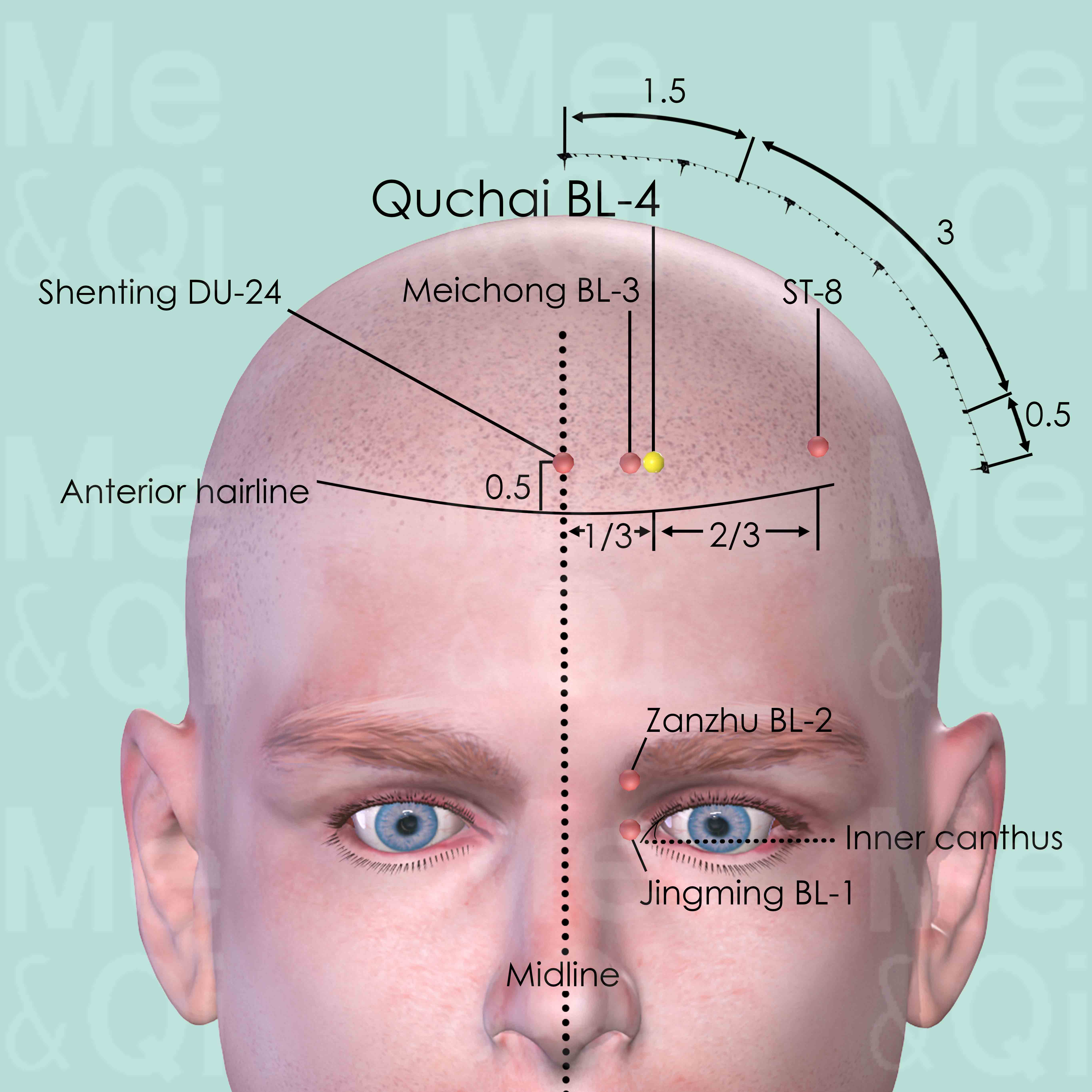
Qucha BL-4
0.5 cun superior to the anterior hairline and 1.5 cun lateral to the anterior midline, at the junction of the medial third and lateral two-thirds of the distance from anterior midline to Touwei ST-8.
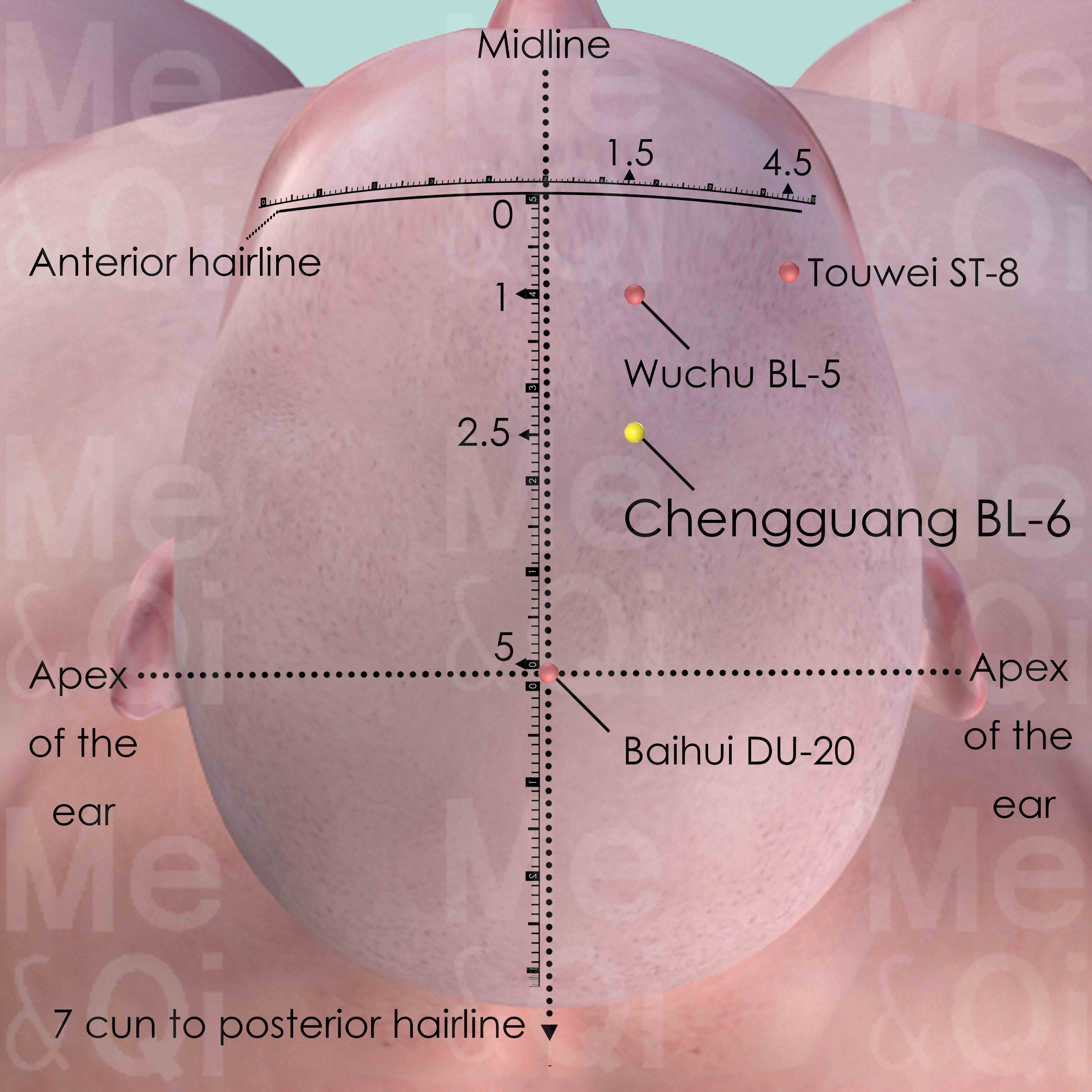
Chengguang BL-6
1.5 cun lateral to the anterior midline and 2.5 cun within the anterior hairline. On the other hand, this point is at the medial third and lateral two-thirds of the distance from anterior midline to the line vertically from Touwei ST-8. Chengguang BL-6 is also 1.5 cun posterior to Wuchu BL-5.
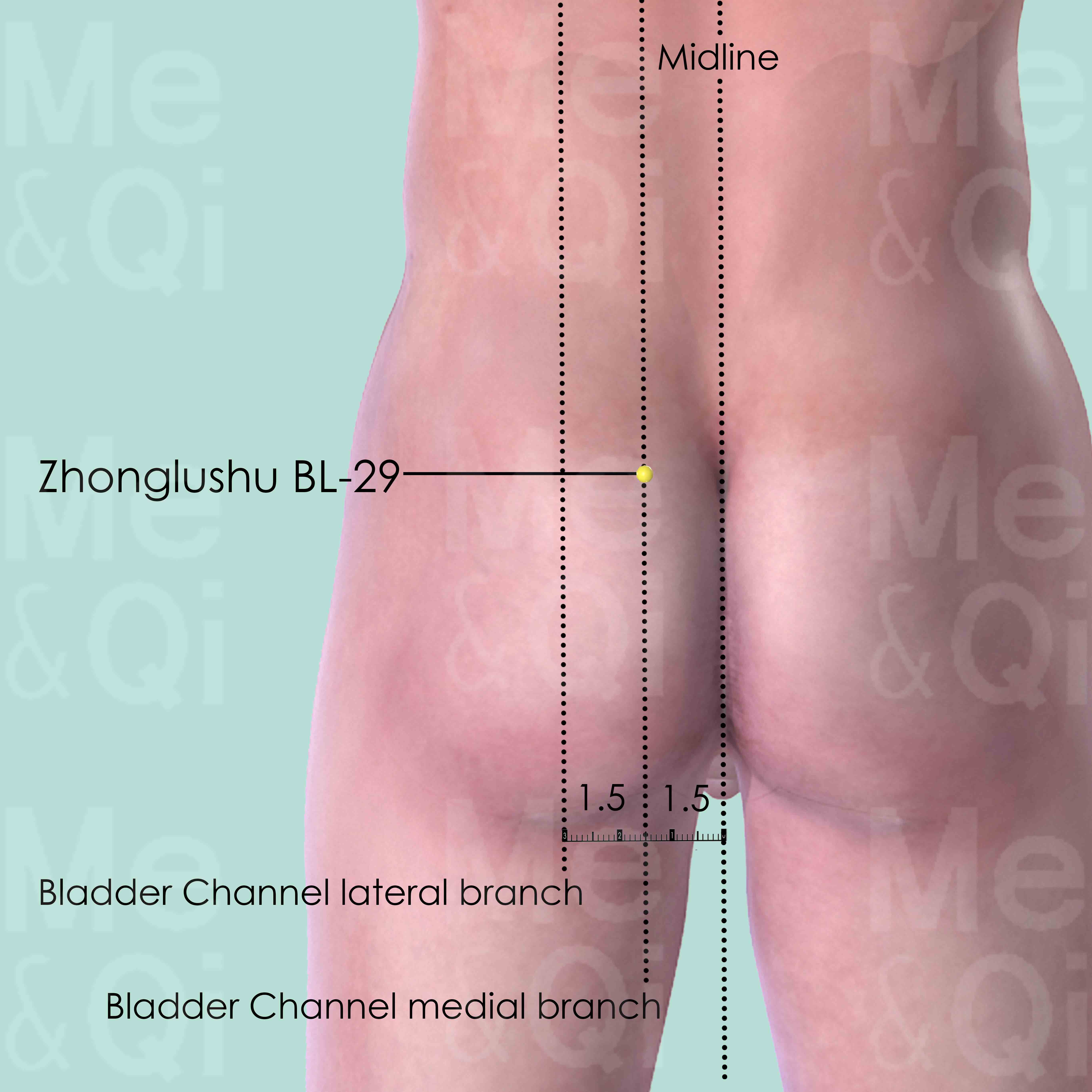
Zhonglushu BL-29
At the level of the 3rd posterior sacral foramen, 1.5 cun lateral to the posterior midline.
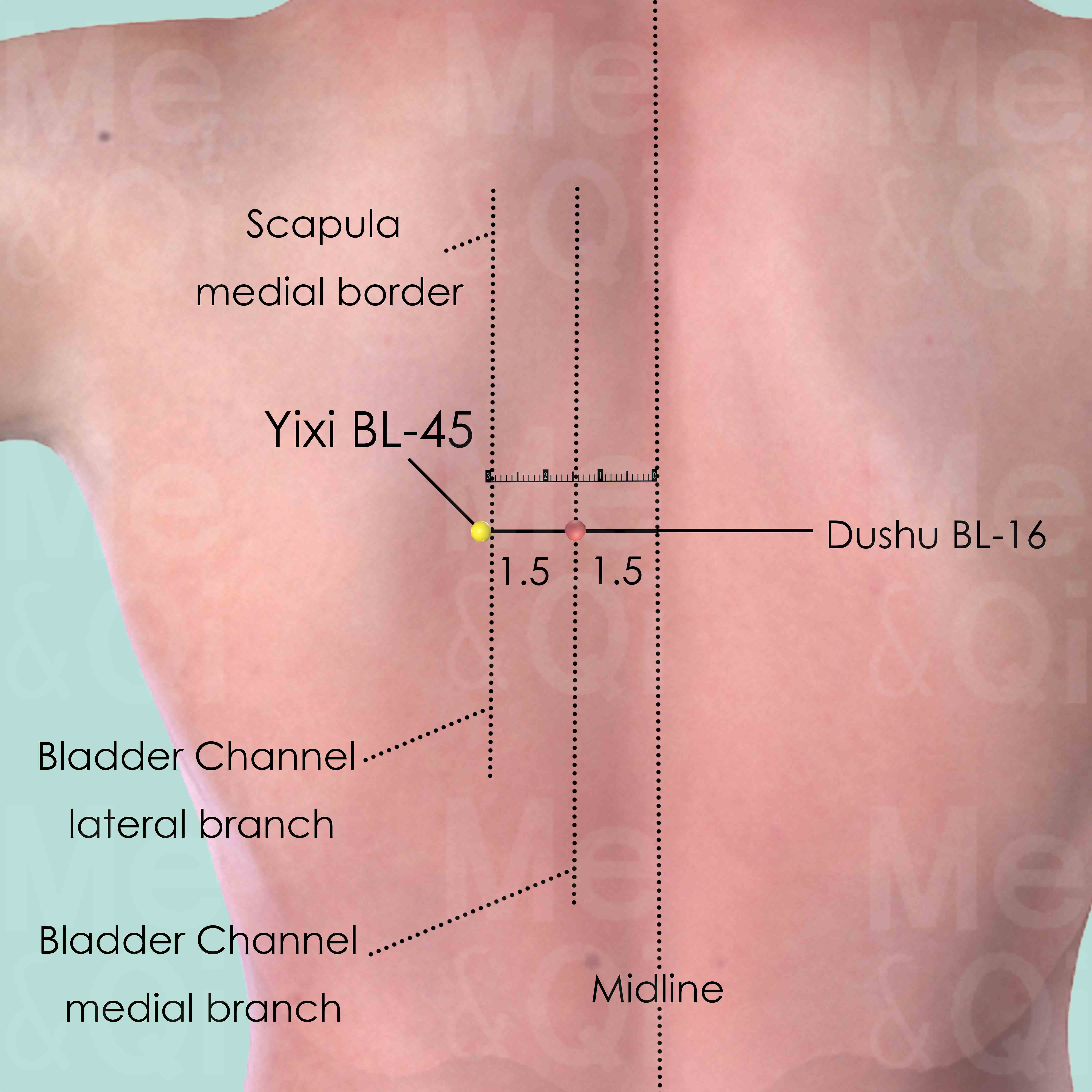
Yixi BL-45
3 cun (about 4 finger-breadths) lateral to the lower border of the spinous process of the 6th thoracic vertebra (T6).
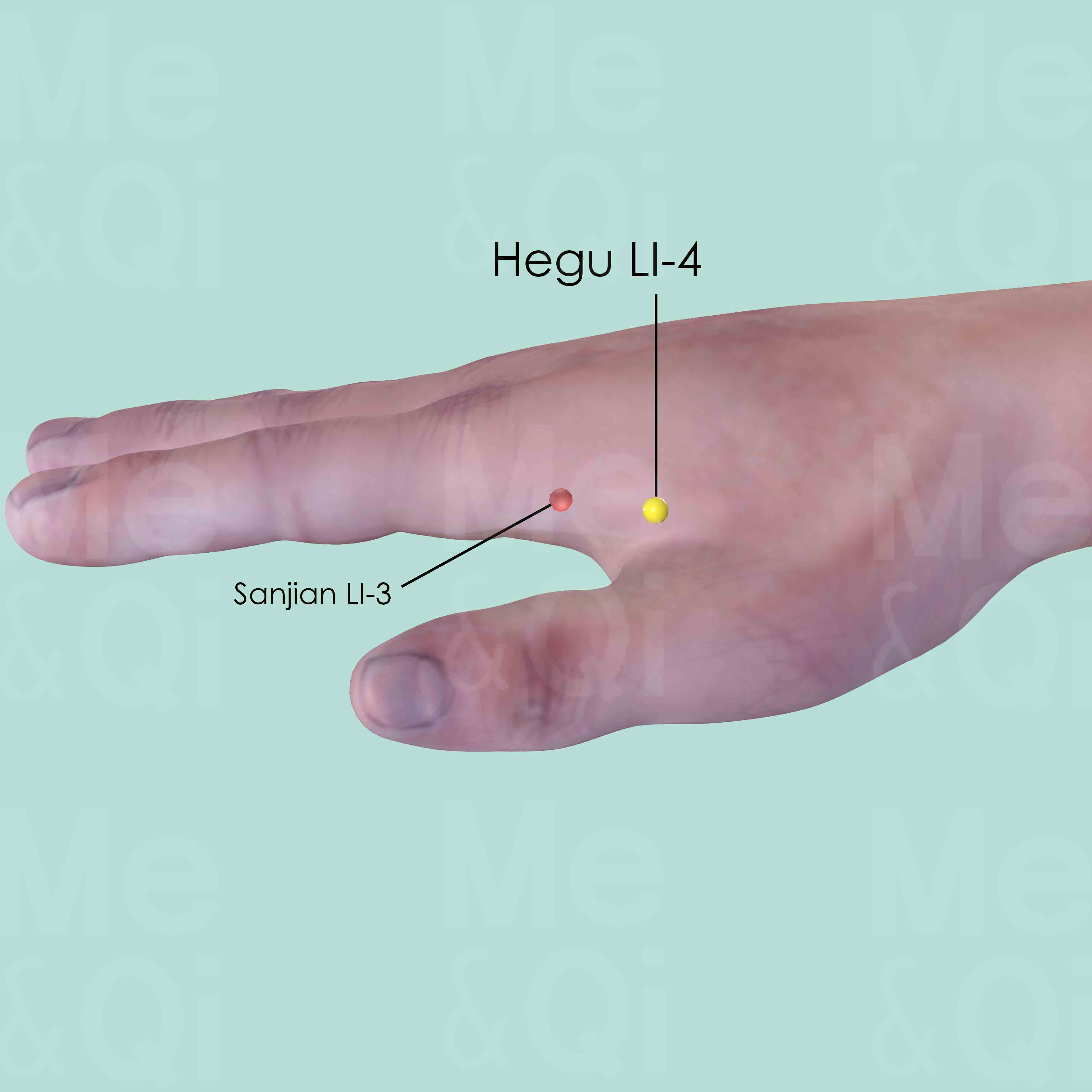
Hegu LI-4
Between the 1st and 2nd metacarpal bones, approximately in the middle of the 2nd metacarpal bone on the radial side.
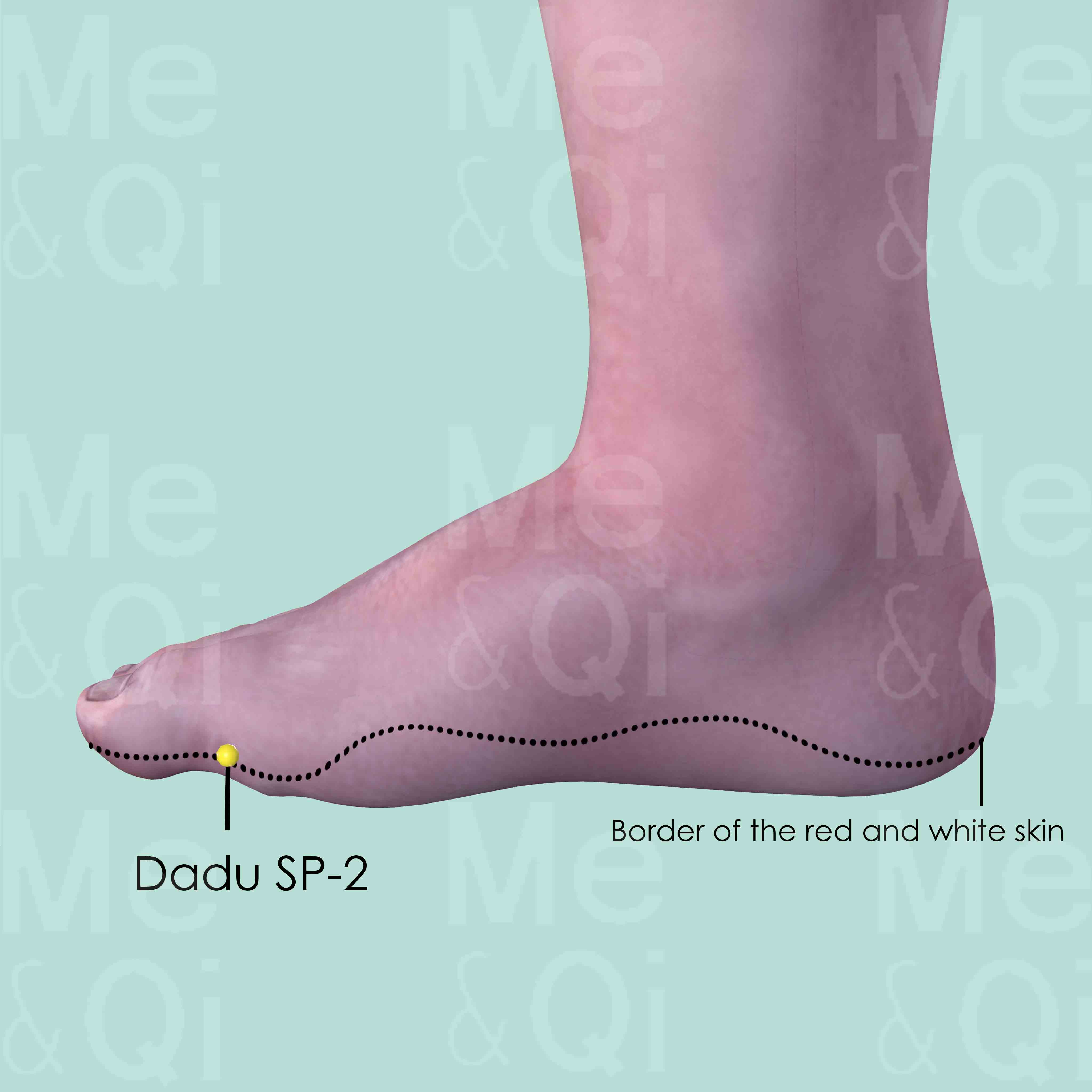
Dadu SP-2
On the medial aspect of the big toe, at the junction of the shaft and the base of the proximal phalanx, distal to the 1st metatarsophalangeal joint.
